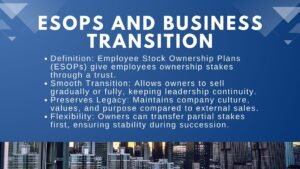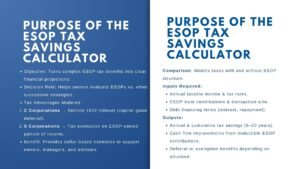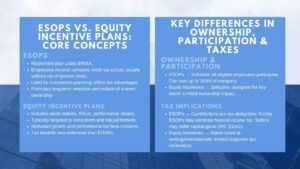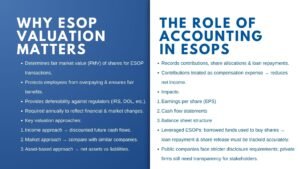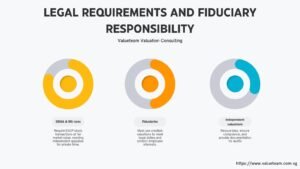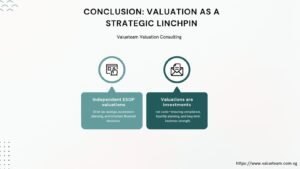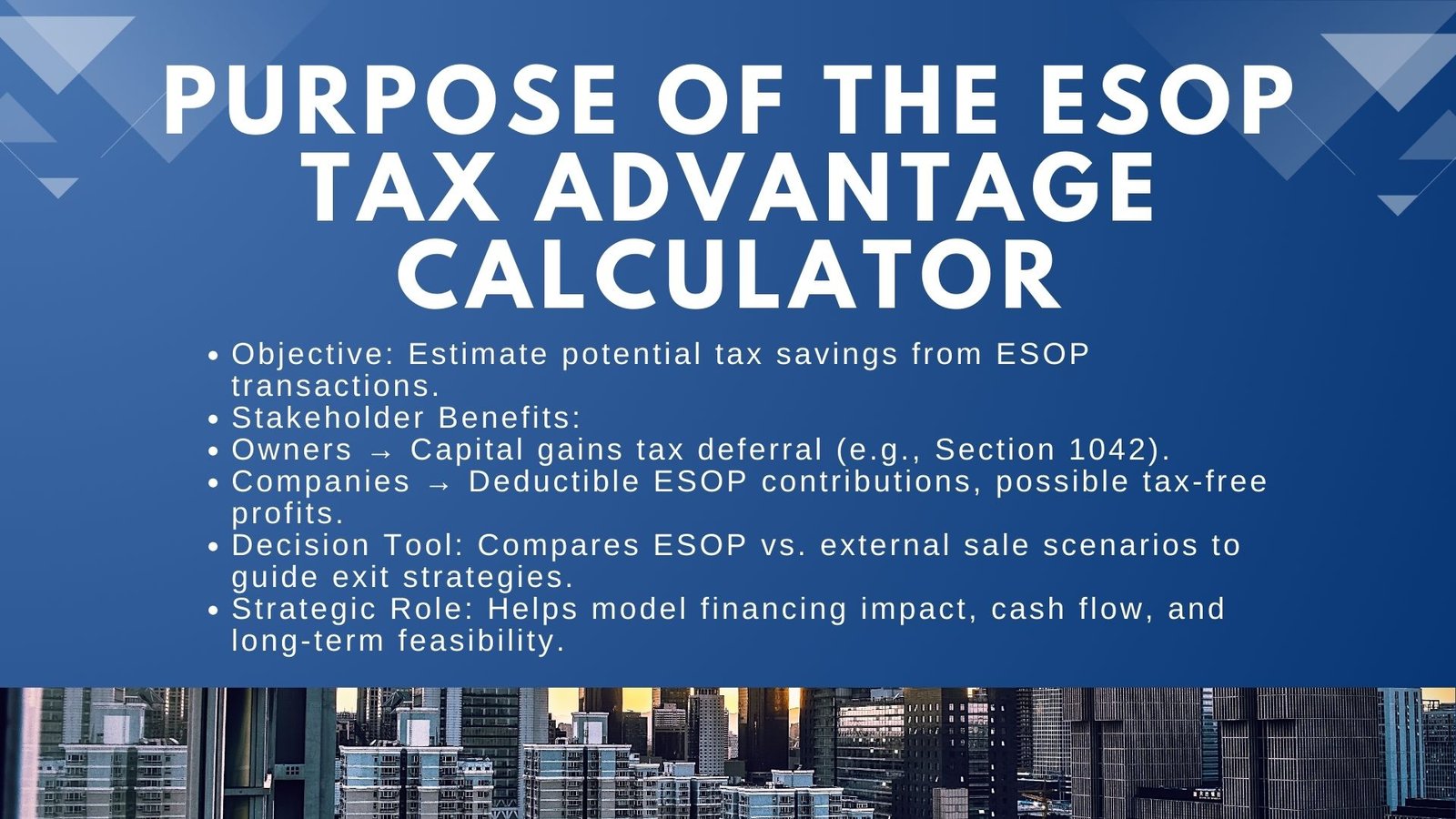
How the ESOP Tax Advantage Calculator Works
Learn How the ESOP Tax Advantage Calculator Works
An Employee Stock Ownership Plan (ESOP) has become one of the more flexible methods of business succession, employee retention and wealth creation plans. Albeit the praise that ESOPs are lauded for aligning employee interests with company performance, one of the most attractive qualities that ESOP presents is the prospect of substantial tax benefits. The tax advantages may accrue to the selling shareholders or the company itself; and under certain circumstances, they may lead to a significant long run savings.
Awareness of the possible tax savings is necessary in business owners considering ESOPs as they make their decisions. Here the ESOP Tax Advantage Calculator is in order. It is an economic instrument that can be used to quantify the business in terms of tax advantages of undertaking an ESOP, which gives a fair overview of the level of economic contribution of the deal as well as future performance of the industry on a clear scale.
The process may be simple to envisage but the workings of the calculator require careful intertwining of valuation, taxation requirements and ESOP-inspired financial considerations. In many cases, organizations also explore tools like a business valuation calculator Singapore for companies to complement their ESOP planning.
The Purpose and Role of the ESOP Tax Advantage Calculator
The ESOP Tax Advantage Calculator, the main purpose of which is to measure the estimated savings on taxes that may be induced by an ESOP transaction. Most business owners have heard that ESOPs offer favorable tax treatment, highlighting the Tax advantages of ESOP for business owners Singapore, but they usually do not have a firm grasp on how significant tax savings can be relative to the structure of a typical sale to an outsider buyer. It might be hard to compare the advantages of an ESOP with other exit strategies without making the appropriate calculations, often supported by Employee stock option valuation in Singapore.
Such a calculator can be used as a decision-making tool that would assist the stakeholders to project what would have happened in different scenarios. In the case of selling shareholders, it may determine the impact of a deferral of capital gain taxes using instruments such as section 1042 of the interior revenue code in the United States. In the case of companies, it has the ability to estimate continuous deductions of ESOP contributions which are usually deductible. Depending on the circumstances, the ESOP is sometimes in a position to pay no federal income tax whatsoever (some corporations along with the business) further increasing after-tax cash flow.
Also, an effect of transaction financing can be modeled with the help of the calculator. Leveraged buyout of ESOP transactions is usually favored as the source of funds that can be used to finance such transactions whereby the company borrows the finance and buys company shares on behalf of the owner. The offsetting of this debt against the tax benefits of the ESOP, can be modelled to determine how fast it will pay back the loan as well as short and long term effects of cash flow. Inclusion of these factors turns the calculator into not only a basic tax estimator; it is also a tool of strategic planning aimed at considering the long-term feasibility of an ESOP.
The Core Data Inputs for Accurate Calculation
The ESOP Tax Advantage Calculator needs right information inputs to generate quality outcomes. Some of the standard financial items that they will include are the current valuation of the company and the planned percentage of shares that the company plans to sell to the ESOP, annual revenue and profitability of the company, the current amount of debt carried and the tax rate. In the absence of accurate input values, the estimated benefits might not be accurate.
The fair market value of the company is perhaps one of the most important initial places to start with. Typically this is determined in an independent appraiser-conducted formal ESOP valuation. The valuation is critical in making the transaction meet regulatory standards and give a real factor to estimate tax benefit. The planned amount of the business that will be sold has also relevance since selling a controlling interest may lead to the possibility of accessing friendlier tax rates especially by the sellers desiring to enjoy capital gains deferral terms.
The current tax profile of the company which includes the federal and state tax rates, as well as, any special local tax charges that can be relevant is also another important data. The calculator calculates these rates to estimate the reduction of the company in terms of the deductions or exemptions using these rates in the long run. It will also consider the amount of contribution to the ESOP, which should be equal to the repayment of debt because it requires contributions to service the ESOP acquisition loan.
At last the terms of financing of the buying such as interest rates, repayment period, and structure have significant impact on the amount of tax savings offsetting debt service costs. The calculator allows incorporating all these data into one comprehensive model, which results in an output that will reflect short-term and long-term consequences to the company and its stakeholders.
The Calculation Process and What It Reveals
After inputting the necessary data, the ESOP Tax Advantage Calculator works with the data entered to come up with the amount of possible savings. It entails a number of levels of financial modeling. One is that it calculates the tax savings that the ESOPs annual contributions to the plan create, as an expense to be written off by the company. These can be made both in cash and stock and in the case that the ESOP is leveraged, it is frequently used in making contributions that are made to repay an acquisition loan that ESOP has. These payments are deductible, so the company gets the opportunity to finance its buy out requirements with the help of pre-tax dollars.
To the selling shareholders, the calculator takes into consideration how they will qualify to defer under Section 1042, should it happen. This is a provision that enables owners who sell stock in a C corporation to an ESOP that owns at least 30 percent of the corporation shares, to defers the taxes on their gain as capital gains tax, in case its proceeds are invested in replacement property that qualifies under the transfer. Calculator estimates the amount of tax that would otherwise be payable and the amount that can be deferred and gives a direct indicator of the personal financial gain to the seller.
These direct benefits are complemented by the calculator modeling persistent operational tax savings. As an example, when an ESOP purchases all shares of an S corporation, the company itself will no longer be liable to pay federal income tax. This implies that the ESOP will receive future profits tax free and this amounts to augmenting the cash flow, and even hastening the payment of debt. The calculator also displays how such savings accrue as time goes on and thereby stakeholders can visualize the long term value of ESOP structure.
When measured against a scenario where the company is sold to an external buyer, the calculator has the ability to show the net benefit of using an ESOP over the seller. In numerous instances, a significant difference arises whereby the ESOP alternative is more appealing despite a similar start price.
Interpreting the Results for Decision-Making
The product of an ESOP Tax Advantage Calculator is normally expressed in terms of a sequence of financial forecasts over a fixed period of time such as five to ten years. Such projections will reveal how the resulting tax savings will accumulate and how they would interact with the debt load of the company and the cash flow that the company would have to manage. In other instances, the calculator may also give a present value calculation, which could display the net value of taxes savings of the ESOP in comparison with other exit options.
To the owners, it is priceless information that can be used to plan on the form and timeframe of the transaction. An estimated tax savings that is relatively high may support a more aggressive finance structure or play a part in a move that will involve selling a greater share of the business. It also can make recommendations in the reinvestment plan of proceeds in the event deferral of capital gains is sought.
The results can guide operation planning of the company. In the event that the ESOP is expected to result in material future tax savings, the management may decide to apply those savings to growth projects, and benefit employees or reduce debt. By doing so, the calculator does not just assist in gauging whether a particular ESOP is financially viable but also assists in strategizing overall.
Nevertheless, the result ought to be put into context. The projections that are given by the calculator are restricted to the erroneousness of the assumptions and inputs that one gives. The actual performance may be affected by the economic conditions, change in the tax laws, and ups and downs of business performance. Thus, although the calculator provides a powerful tool, its estimate must be taken into consideration in conjunction with professional recommendations of both valuation professionals, such as tax advisors and ESOP consultants.
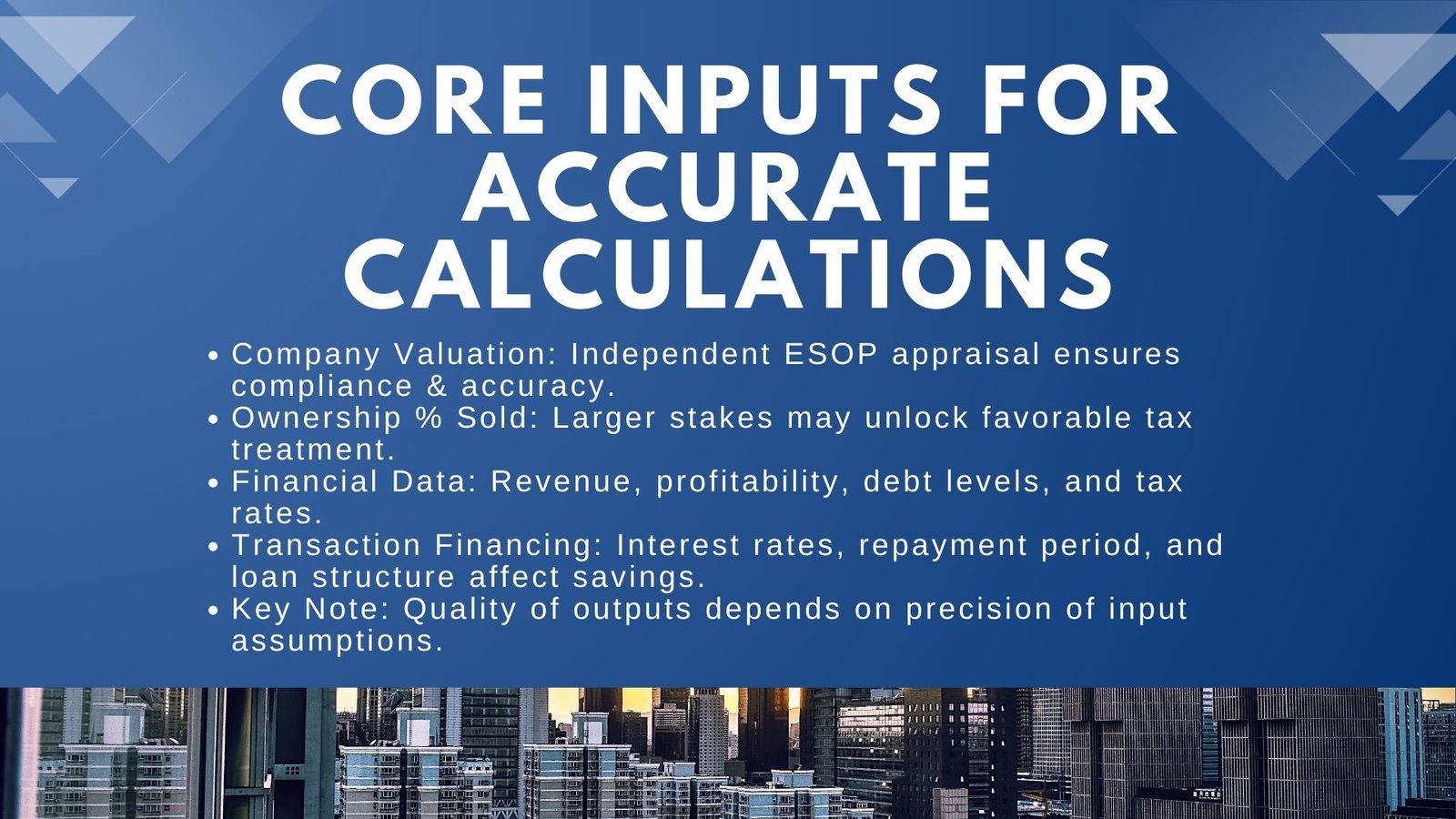
Why a Calculator is Only the First Step
Although the ESOP Tax Advantage Calculator may be very handy, it does not eliminate the mechanism of the full feasibility study or the professional advisory process. The calculator gives a rough idea at a higher level but there are legal and regulatory issues as well as operational complexities that implementing an ESOP will have that need to be addressed by some experts.
Where a feasibility study outlines the cost of the tax savings estimate, it also considers the level of preparedness of the company in keeping with an ESOP, the effect of the ESOP on the culture of employees within the company, and the compliance cost of the running of the plan. These larger issues can be put in perspective by professional advisors to make sense of the calculator output and the decision to adopt an ESOP is therefore informed by a bottom line analysis on the pluses and the debits.
Also, legislation changes may significantly modify the benefit by the calculator relying on the assumption that the current tax laws would apply. As an example, a change in corporate tax rate, change in capital gains tax rates, or change in ESOP specific provisions could alter the correctness of the projections. It is thus important to ensure that the analysis is updated on a regular basis especially as the years approach the year of a planned transaction.
In conclusion, it is imperative to consider the ESOP Tax Advantage Calculator as an introduction to what can prove to be the most impressive monetary side of having an ESOP; it is not, however, the only determining matter to go out of your way to do it. When applied as part of an overall program of professional assistance and an in-depth transaction plan, it can allow business owners the clarity and confidence necessary to move to the next step with a successful ESOP implementation.

